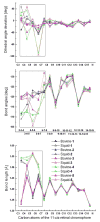QM/MM study of dehydro and dihydro β-ionone retinal analogues in squid and bovine rhodopsins: implications for vision in salamander rhodopsin
- PMID: 20964383
- PMCID: PMC2988495
- DOI: 10.1021/ja105050p
QM/MM study of dehydro and dihydro β-ionone retinal analogues in squid and bovine rhodopsins: implications for vision in salamander rhodopsin
Abstract
Visual pigment rhodopsin provides a decisive crossing point for interaction between organisms and environment. Naturally occurring visual pigments contain only PSB11 and 3,4-dehydro-PSB11 as chromophores. Therefore, the ability of visual opsin to discriminate between the retinal geometries is investigated by means of QM/MM incorporation of PSB11, 6-s-cis and 6-s-trans forms of 3,4-dehydro-PSB11, and 3,4-dehydro-5,6-dihydro-PSB11 and 5,6-dihydro-PSB11 analogues into squid and bovine rhodopsin environments. The analogue-protein interaction reveals the binding site of squid rhodopsin to be malleable and ductile, while that of bovine rhodopsin is rigid and stiff. On the basis of these studies, a tentative model of the salamander rhodopsin binding site is also proposed.
Figures




References
-
- Sekharan S, Altun A, Morokuma K. Chem Eur J. 2010;16:1744–1749. - PMC - PubMed
- Sekharan S, Morokuma K. J Phys, Chem Lett. 2010;1:668–672. - PMC - PubMed
- Altun A, Yokoyama S, Morokuma K. J Phys Chem B. 2008;112:16883–168890. - PMC - PubMed
- Altun A, Yokoyama S, Morokuma K. J Phys Chem A. 2009;113:11685–11692. - PMC - PubMed
-
- Dartnall HJ, Lythgoe JN. Vision Res. 1965;5:81–100. - PubMed
Publication types
MeSH terms
Substances
Grants and funding
LinkOut - more resources
Full Text Sources

